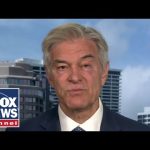In a lively and contentious meeting, former President Donald Trump recently engaged in a fiery discussion with the President of South Africa. The topic that sparked this heated debate? The idea of “white genocide” in the African nation, a claim that has stirred controversy and confusion. Trump, demonstrating his signature flair for dramatic exchanges, apparently found himself quite flustered when NBC reporter Peter Alexander dared to question his statements on the matter.
The encounter took a turn when Trump referred to Alexander’s report as “totally fake news,” sending him back to his studio with a not-so-pleasant remark. It seemed like the former President was not in the mood for critical questions about his views, especially on such a sensitive topic. Instead, he launched into a discussion that included a video depicting alleged mass graves and violence against white farmers in South Africa. The visuals were striking, and Trump claimed that white farmers were being targeted while little to no consequences followed for the perpetrators. This assertion drew sharp disagreements from many, who pointed out that the majority of victims in South Africa are, in fact, black citizens.
While Trump vehemently insisted on the existence of a dramatic crisis, analysts and critics voiced their concerns about the validity of his claims. Some experts contend that he was merely spreading a narrative without substantial evidence to back it up, which, alas, has sadly become a familiar theme in contemporary political discussions. What’s even more perplexing is the reliance on certain images that some claimed were staged props used in protests, not evidence of genocide.
Interestingly, this interaction reflects deeper underlying issues within Trump’s approach, particularly concerning immigration policies. The former President has long maintained an anti-immigrant stance, which many see as more than just a policy choice; it is a recurring theme that plays into broader narratives that can polarize viewers. The mention of allowing white South Africans to immigrate while restricting others paints a picture of a certain narrative that Trump continues to push.
All of this unfolds against a backdrop of media criticism, where journalists are increasingly under scrutiny for their coverage of Trump’s statements and behaviors. Some argue that the media’s reaction to Trump’s claims contributes to a cycle of distrust. Regardless of the perspective one holds, it is evident that the tensions between Trump’s statements and the media’s portrayal are charged with implications for how information is consumed and understood by the public.
As these discussions progress, one thing remains clear: Trump’s ability to command attention and galvanize debate around controversial issues continues to play a key role in American political discourse. Whether one agrees or disagrees with his assertions, his approach keeps the conversation alive, albeit often embroiled in chaos and confusion. In the ever-evolving theater of politics, one can only wonder what scene will unfold next.




